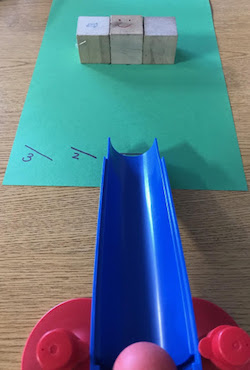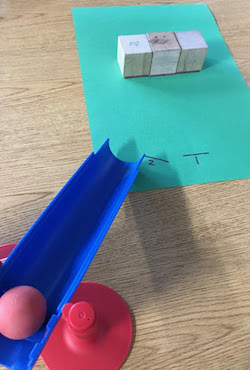






Objects do not move on their own.
Analyze and interpret data about the cause and effect of objects colliding.
A ball thrown against a wall changes direction.
Click here for NGSS, CCSS-ELA, and California ELD standards.
What happens when a moving ball hits a wall?
In the previous lessons, investigative phenomena using explorations with pushes and pulls established that pushes and pulls can stop objects or move them in different directions. Wind can push objects, too. The force of the push or pull will impact the distance traveled during the movement. (DCI)
In this lesson, the investigative phenomenon is “A ball thrown against a wall changes direction” which explores the question of how to get a ball around defenders in soccer. The activity for the investigation begins by observing how a ball moves in a wall ball game. This deepens understanding of the concept that when objects collide, the direction of the movement changes in predictable patterns. (DCI)
In this mini-wall ball exploration, a ball is rolled down a ramp to collect data about the effect of a ball colliding with a wall. (SEP) The ramp is used to keep the force of the ball consistent during the investigation. Data will be collected and recorded to show how changing the ramp’s angle affects the collision of the ball with the wall. This data will be used to collaboratively discuss the cause and effect phenomena of how the changes with the ramp cause predictable patterns of collisions with the wall. (CCC)
Wall ball helps build an understanding of how players on a soccer field are used as collision points that can change the direction and strength of a push on a soccer ball. This investigation adds to the knowledge of how motionless objects can be made to move. (Anchoring Phenomenon)
The final lesson: Lesson 6: Collision Goal! uses an investigative problem of designing a predictable strategy/solution to play a tabletop game of soccer.
Throughout the lesson, a flag ( ) denotes formative assessment opportunities where you may change instruction in response to students’ level of understanding and making sense of phenomena.
) denotes formative assessment opportunities where you may change instruction in response to students’ level of understanding and making sense of phenomena.
| Part I | 35 minutes | |
| 10 minutes | Engage I | |
| 15 minutes | Explore I | |
| 10 minutes | Explain I | |
| Part II | 45 minutes | |
| 10 minutes | Explore II | |
| 20 minutes | Explain II | |
| 10 minutes | Explore III | |
| 5 minutes | Elaborate/Evaluate |
Every time the ball hits an object, it offers an opportunity to ask about cause and effect. By this point students should be familiar with the idea of cause and effect, so be explicit in using this language.
Ask questions based on observations about the cause and effect of objects colliding in different games.
Make observations about the cause and effect of objects colliding.

Record observations about patterns of cause and effect of objects colliding.
This is a good time to introduce to students a symbol for collision and to reinforce the use of arrows to show direction in their own diagrams and in class diagrams. This will help familiarize them with these symbols for the following day’s activity.
 [Used with Permission] |
 [Used with Permission] |
Use and share observations of the effect that a collision has on the motion of an object.
Record observations to collect data about the cause and effect of objects changing direction after a collision.
Many kindergarten students do not consider rules as a constant in a game. Therefore, you may want to add a list of game rules using pictures for students to refer to.
 |
 |

Use and share observations of the effect that a collision has on the motion of an object.

Collisions affect the observed motion of an object in games.
 Wrap up today’s investigation asking students to choral read the notebook page labeled “Things That Happen When Objects Collide.” Discuss what patterns are recorded about how objects change direction after a collision. Ask individual students to draw a picture of what happens when objects collide. Use arrows, asterisks, and pathways to show where the object starts, collides, changes direction, and ends up.
Wrap up today’s investigation asking students to choral read the notebook page labeled “Things That Happen When Objects Collide.” Discuss what patterns are recorded about how objects change direction after a collision. Ask individual students to draw a picture of what happens when objects collide. Use arrows, asterisks, and pathways to show where the object starts, collides, changes direction, and ends up. Collect the individual K.5.H1: Recording Sheets to evaluate for patterns that show that students understand that changing the starting point changes the collision and the resulting path of the ball to the basket. Use this rubric to score the work.
Collect the individual K.5.H1: Recording Sheets to evaluate for patterns that show that students understand that changing the starting point changes the collision and the resulting path of the ball to the basket. Use this rubric to score the work.
Note: If students are not understanding using a collision to change direction include the mini-wall ball game in the choice center or ask students to set up different tracks with ramps and cars that will collide and change direction.
It would be appropriate to have students interact with text to extend their understanding of movement. These selections can be read aloud at any time after this lesson where students have experienced pushes and pulls and change of direction. Suggested books include the following:
Nonfiction:
Boothroyd, J. (2010). Give It a Push! Give It a Pull! New York, NY: Lerner Digital.
Bradley, K. B., & Meisel, P. (2010). Forces Make Things Move. New York, NY: HarperCollins.
Curry, D. L. (2001). How Things Move. Mankato, MN: Yellow Umbrella Books.
Endres, H. J. (2004). Push and Pull. Bloomington, MN: Yellow Umbrella Books.
Guillain, C. (2012). Push and Pull. London: Raintree.
Murphy, P. J. (2002). Push and Pull. New York, NY: Children’s Press.
Navarro, J. (2011, March 5). William’s Wall Ball Tournament-Game 5. Retrieved from https://www.youtube.com/watch?v=rhsAKRn10G4
Nelson, R. (2004). Push and Pull. Minneapolis, MN: Lerner Publications.
Schaefer, L. M. (2000). Push and Pull. Mankato, MN: Pebble Books.
Stille, D. R., & Boyd, S. (2004). Motion: Push and Pull, Fast and Slow. Minneapolis, MN: Picture Window Books.
K.5.C1: Class Notebook |
Download K.5.C1 |
K.5.H1: Recording Sheet |
Download K.5.H1 |
K.5.R1: Wall Ball Directions |
Download K.5.R1 |
K.5.R2: Mini-Wall Ball Set |
Download K.5.R2 |